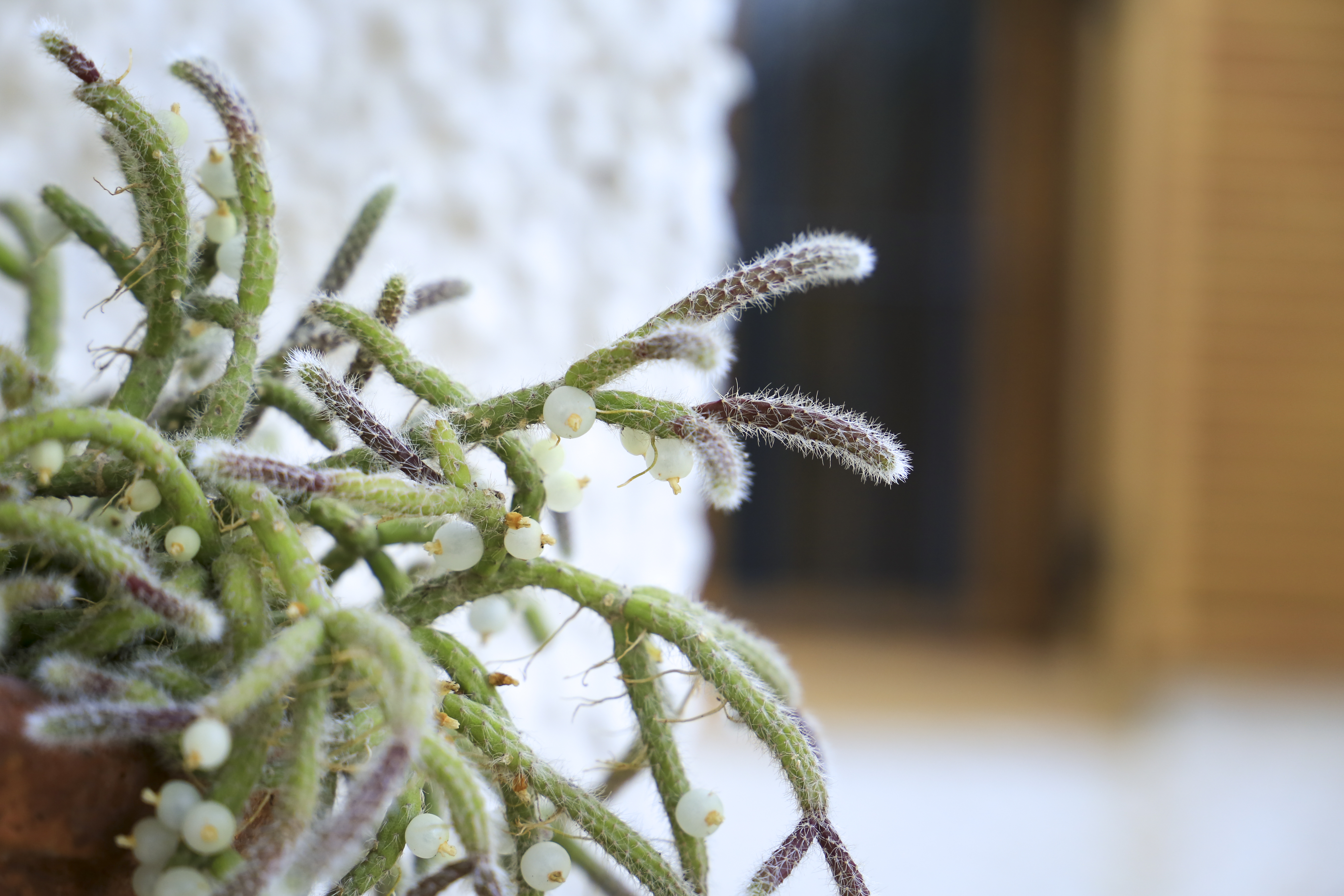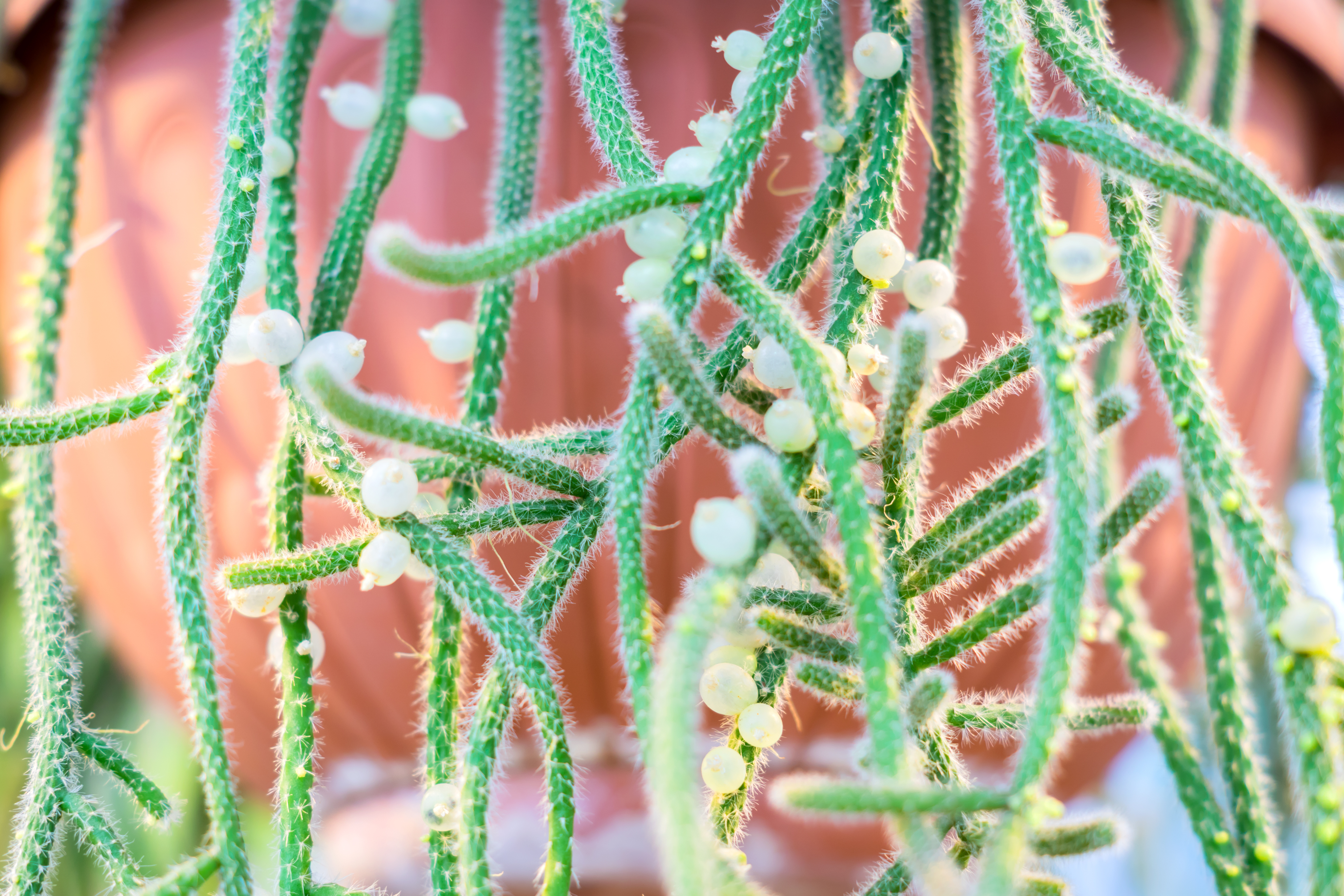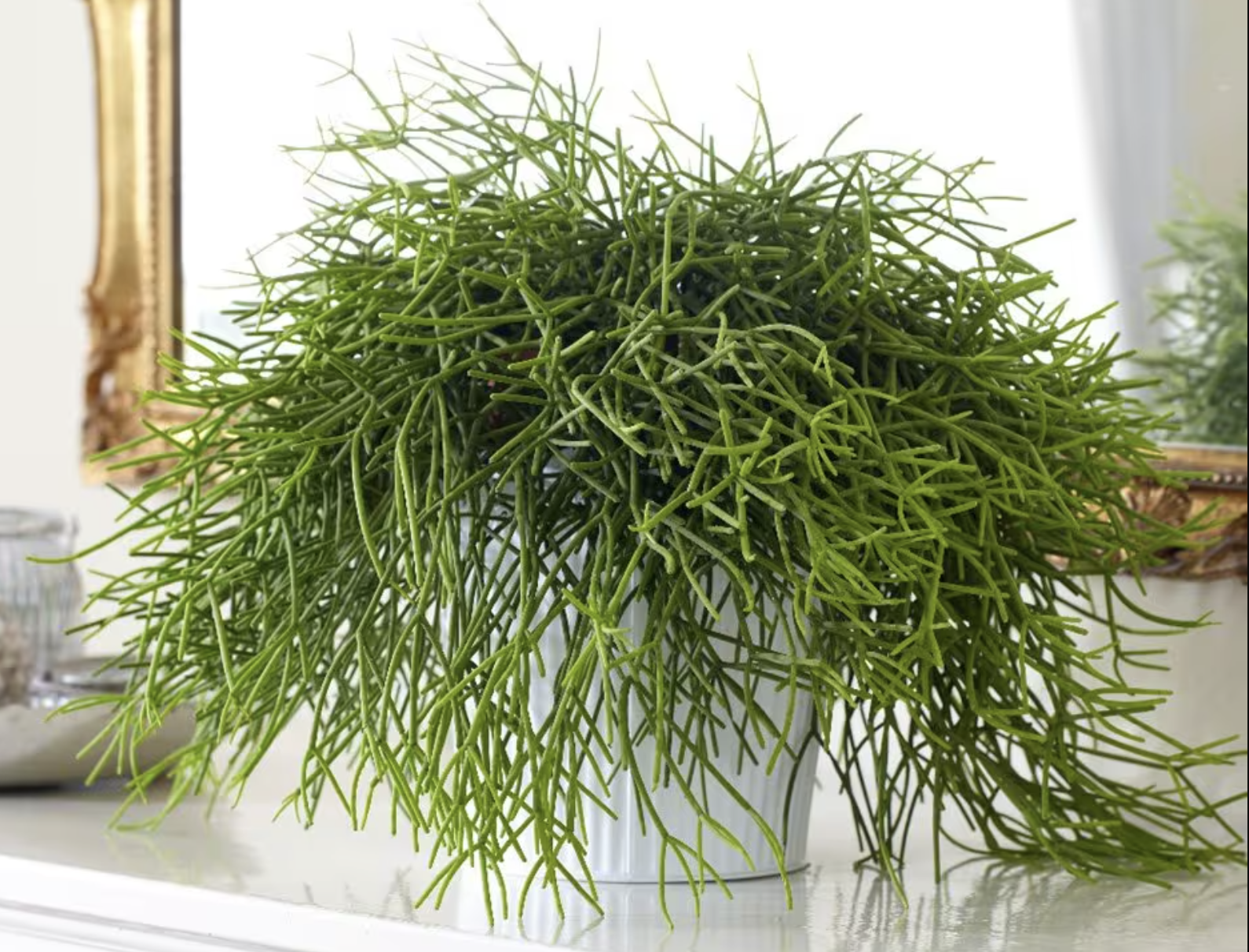
Some plants are easier to propagate than others, and the Rhipsalis baccifera, otherwise known as the Mistletoe cactus, is one of those easy types. It's full of color and certainly brings unique foliage into the home, so why not double it and spread it around your space?
If you enjoy decorating with cacti, then you'll love decorating with this beauty. It carries a mop of vibrant green tendrils and little white berries. It's the white berries that resemble those on mistletoe that earn this plant its nickname. And it's the tendrils that make it so easy to double your plant or even treble, quadruple, and more–you get the picture.
Hailing from the rainforest, this cactus doesn't have prickles either, so it's easy to handle. If you love your Mistletoe cactus and want to see it flourish beyond your living room, here's how to propagate your Mistletoe cactus and double your plant in three simple steps.
Propagating a Mistletoe Cactus

As well as being easy to propagate, Rhipsalis baccifera are great low-maintenance plants for indoor gardening, adding interest and vibrancy to your home with few demands.
"The Rhipsalis baccifera practically begs to be propagated," says Lindsay Sisti, founder, All the Plant Babies and author, The Ultimate Guide to Houseplant Propagation. "This cactus naturally forms segments that can be easily broken off to propagate individually."
Lindsay continues: "It also produces adventitious (aerial) roots along its entire stem prior to propagation. These roots are more prominent in humid climates; otherwise, they may simply appear as small bumps along the stems. The adventitious roots that you put in contact with the soil during propagation are typically the ones that will extend and grow down into the potting mix, allowing the cutting to fully take root."
Step 1: Take Some Cuttings

Most plants can be propagated by taking seeds or by cuttings. The latter is generally the simplest and most popular way, particularly if you want to avoid houseplant propagation mistakes. So, this is our focus for this step-by-step guide.
"The three main ways to propagate this jungle cactus is to take stem cuttings and root them horizontally on top of the substrate, take stem cuttings and stick them vertically into the substrate, or by harvesting Rhipsalis berries and sowing the seeds inside," says Lindsay. "Stem cuttings are by far the most accessible propagation method, as it can be done year-round inside your home. Additionally, the natural urge to give your Rhipsalis a haircut is hard to resist. The cuttings will likely take root faster during the sunnier months of spring and summer."
When choosing cuttings, Megan Cain, founder, The Zen Succulent advises selecting healthy stems. "Ideally one that’s a few inches long," says Megan. "Look for plump, firm stems without any signs of yellowing or damage.
Megan says you should use sterilized scissors or pruning shears to snip off and remove the cuttings. We particularly like these Haus & Garten ClassicPRO 8.5" Professional Premium Titanium Bypass Pruning Shears from Amazon. "Aim for a 3-4 inch piece (around 8-10 cm) to give the new plant a strong start. Snip just below a node (the little bump where roots will sprout)," explains Megan.
"You can sterilize your scissors or shears with alcohol to remove any pathogens," advises Lindsay.
Step 2: Leave the Cuttings to Dry

Once you've snipped the cuttings off below the node, they will need to dry out a little before you can plant them. Follow this step with care to get the best from your indoor succulents.
Megan tells us: "Set the cutting or cuttings aside in a warm, shaded area for a day or two to let the cut end callous over. This step is essential for preventing rot when it’s time to plant them."
Lindsay notes that "It will also prevent the cuttings from absorbing too much water or pathogens during propagation."
Step 3: Plant Your Cuttings

After a couple of days, when the cut ends of the cuttings have dried and calloused over, it's time to plant them up. Choose a suitable indoor planter and fill it with a coarse, well-draining potting mix. This Miracle-Gro Cactus, Palm and Citrus Potting Mix, For Container Plants from Walmart priced at $9.55, is a great companion for your cacti.
"A pot 2-6” in diameter with drainage holes (depending on how many cuttings you plan on taking) is best," says Lindsay. "Look for a potting mix suitable for a jungle epiphyte like a Rhipsalis. Succulent potting soil with 25% extra pumice or perlite mixed in, or 60% indoor tropical potting soil with 40% orchid potting mix is also suitable. Their epiphytic roots demand a well-aerated root zone and will appreciate pine bark or coco coir to grab onto to mimic a tree in the wild.
Lindsay continues: "Ideally, the surface area of the soil should be just enough so that the cuttings nearly fill the pot. Adjust your pot size or number of cuttings accordingly. Ensure that the pot has drainage holes at the bottom," continues Lindsay. Insert your cuttings cut-side down into the potting mix, roughly ½ inch down, or just far enough so that they stand upright. Water the potting mix evenly and thoroughly and until water drains out of the bottom of the pot.
Alternatively, Lindsay says, "These plants grow wonderfully in a semi-hydroponic substrate such as Lechuza pon in a self-watering pot, which takes the guesswork out of watering."
"Mistletoe cactus loves warmth," explains Megan. "So place your newly potted cutting(s) in a warm, bright space with indirect light. Direct sun can be too harsh at this stage, so a bright but shaded spot is perfect."
Care and Maintenance Tips

This plant is easy to care for, as long as it has the right conditions, which are those as close to its natural habitat as possible.
"Aim for bright, indirect light," says Megan. "This cactus originates from rainforest canopies, so it’s accustomed to dappled or filtered light rather than direct sun. Water it sparingly until roots are well established, generally every one to two weeks, allowing the soil to dry between waterings. Although, once established, mistletoe cactus prefer a bit more moisture than typical cacti. During warmer months, water every one to two weeks and reduce watering in winter, about every three to four weeks."
The expert notes that this special cactus enjoys moderate humidity. She adds, "Mistletoe cactus enjoys moderate humidity, unlike many cacti. So, place it near other plants to create a naturally more humid environment or mist occasionally, especially if your home is very dry."
During the spring and summer, Megan says you should feed it montly with balaced, diluted house fertilizers. We love this Easy Peasy Liquid All Purpose Indoor Plant Food from Amazon.
"Skip fertilizing in fall and winter when the plant naturally slows down," Megan adds.
FAQs
How fast does the mistletoe cactus grow?

This is an easy plant to grow, so you can see good results in a short time. "Mistletoe cactus has a moderate growth rate, and with good care, it can start filling out within a few months," says Megan Cain. "Older, well-established plants can double in size each year, especially if they’re given a bit of extra love in the form of light, water, and nutrients."
Can mistletoe cactus live outside during winter?
Mistletoes cactus, Rhipsalis baccifera, is a tropical plant, so this very much depends where you live. "Rhipsalis are endemic to jungle climates and thrive within a temperature range of 45°F to 98°F, favoring the warmer end of that spectrum," says Lindsay Sisti.
"They can be grown outdoors in USDA zones 9a to 11b. These plants will bloom more frequently if kept at consistently high temperatures."







